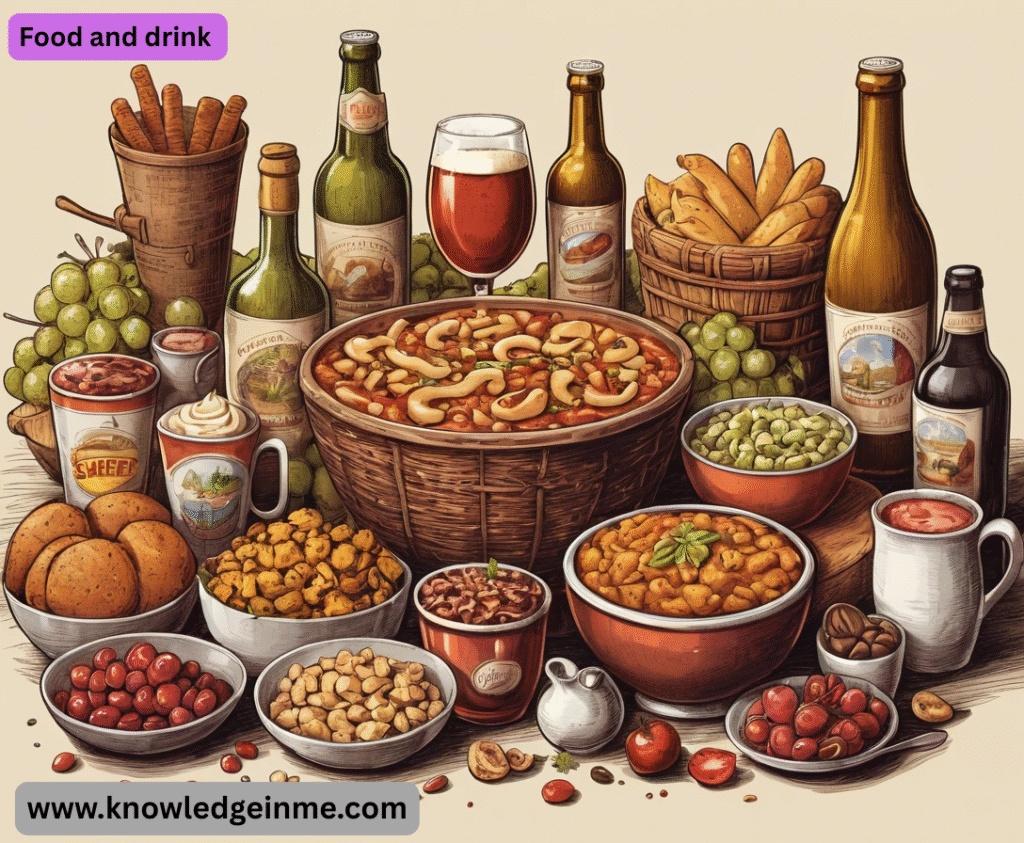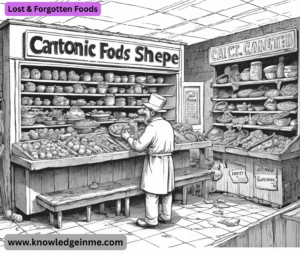Food and drink Food and Drink encompass a vast range of consumables that provide nutrition, pleasure, and cultural significance. Here’s a broad overview:
Categories:
- Fruits & Vegetables – Apples, bananas, spinach, carrots (rich in vitamins).
- Proteins – Meat (beef, chicken), fish, eggs, beans, tofu.
- Grains – Rice, wheat, oats, quinoa (carbohydrates & fiber).
- Dairy – Milk, cheese, yogurt (calcium & probiotics).
- Fats & Sugars – Butter, olive oil, chocolate (in moderation).
Cuisines:
- Italian (pasta, pizza), Japanese (sushi, ramen), Indian (curry, biryani), Mexican (tacos, guacamole).
Dietary Preferences:
- Vegetarian, vegan, gluten-free, keto, paleo.
Drinks
Non-Alcoholic:
- Water (essential for hydration).
- Coffee & Tea (caffeinated or herbal).
- Juices & Smoothies (fruit/vegetable-based).
- Soft Drinks (soda, sparkling water).
Alcoholic:
- Beer, wine, spirits (vodka, whiskey).
- Cocktails (mojito, margarita).
Trends & Health
- Plant-Based Diets – Growing popularity of vegan meat alternatives.
- Functional Foods – Probiotic yogurt, superfoods (chia seeds, kale).
- Sustainability – Organic farming, reducing food waste.
Historical & Cultural Significance
Ancient Diets:
- Egyptians relied on bread, beer, onions, and garlic.
- Romans enjoyed garum (fermented fish sauce) and lavish feasts.
- Aztecs ate maize, beans, and even insects like chapu lines (grasshoppers).
- Spice Trade: Black pepper, cinnamon, and cloves fueled global exploration and wars.
National Dishes:
- Japan: Sushi (originated as fermented fish preserved in rice).
- France: Coq au vin (chicken cooked in wine).
- Ethiopia: Injera (sourdough flatbread) with spicy stews.
Science of Food & Drink
Flavor Chemistry:
- Sweet (sugar), Sour (acid), Salty (sodium), Bitter (alkaloids), Umami (glutamate in mushrooms/soy sauce).
- Maillard Reaction: Browning of meat/seared bread (creates complex flavors).
Fermentation:
- Turns grapes → wine, milk → yogurt, cabbage → kimchi.
- Involves microbes (yeast, bacteria) breaking down sugars.
- Molecular Gastronomy: Modern chefs use liquid nitrogen, spherification (turning liquids into “caviar” balls).
Global Beverage Traditions
Tea Cultures:
- British afternoon tea (with scones).
- Japanese matcha ceremonies.
Coffee Evolution:
- From Ethiopian goat herders discovering coffee beans to Italian espresso culture.
Unique Drinks:
- Kombucha (fermented tea).
- Kvas (Russian fermented bread drink).
- Chicha (Latin American corn-based beer).
Current Trends
- Alt-Meat: Beyond Meat, Impossible Burgers (plant-based proteins that “bleed”).
- Zero-Waste Cooking: Using carrot tops, stale bread (e.g., panzanella salad).
Functional Beverages:
- Adaptogenic drinks (reishi mushroom coffee).
- CBD-infused cocktails.
- Hyper-Local: Foraged ingredients, rooftop honey.
Strange & Extreme Foods
Delicacies:
- Hákarl (Icelandic fermented shark, smells like ammonia).
- Balut (Philippine duck embryo egg).
- Casu Marzu (Sardinian maggot-infested cheese).
Food and drink Luxury Items:
- White truffles ($3,000+ per pound).
- Kopi Luwak coffee (from civet-digested beans).
Food Myths Debunked
- “MSG is bad for you” → No scientific evidence (common in umami foods).
- “Alcohol cooks off completely” → Up to 40% may remain depending on cooking time.
- “Eating fat makes you fat” → Healthy fats (avocados, nuts) are essential.
Future of Food
- Lab-Grown Meat: Cultivated chicken approved in the U.S. (2023).
- 3D-Printed Food: NASA experiments with printed pizzas for astronauts.
- Insect Protein: Crickets flour (high-protein, eco-friendly).
Lost & Forgotten Foods
- Silphium: A Roman-era herb so prized for its flavor (and contraceptive properties) that it was eaten to extinction.
- Mammoth Meatballs: In 2023, scientists grew mammoth meat in a lab using DNA—then made a meatball. (No one dared eat it.)
- Turtle Soup: A Gilded Age delicacy in the U.S., now banned due to endangered species laws.
The Neuroscience of Taste
- Why We Love Junk Food: Sugar/fat combo triggers dopamine like cocaine (Big Food engineers this).
- Sound Changes Taste: Studies show crunchy sounds make food seem fresher (e.g., potato chips).
- Color Illusions: Blue plates suppress appetite; red makes food taste sweeter.
Secret Menus & Underground Food Culture
- In-N-Out’s “Animal Style”: A cult burger with mustard-fried patty, extra spread, and grilled onions (only insiders knew—until the internet).
- Starbucks’ “Short” Espresso: A cheaper, stronger shot served in a tiny cup (not on menus).
- Tokyo’s “Blind Pig” Bars: Hidden speakeasies behind vending machines or unmarked doors.
Food as Warfare & Espionage
- The Great British Tea Heist: 19th-century British spy Robert Fortune stole China’s tea secrets (and plants) to break their monopoly.
- Potato Propaganda: Frederick the Great of Prussia planted royal potato fields—then “guarded” them to make peasants steal and grow them.
- WWII’s “Carrot Vision” Myth: British RAF spread rumors that pilots ate carrots for night vision (to hide their radar tech).
Extreme Eating Records
- Hot Pepper Death: A 2016 case where a man’s esophagus tore from a ghost pepper eating contest.
- Competitive Eating: Joey Chestnut holds the record—76 hot dogs in 10 minutes. (His secret? “Lubing” buns with water.)
- The 100-Year-Old Egg: Chinese pidan (preserved in ash/clay for months) turns black/green—tastes like creamy ammonia.
The Dark Side of Food Industry
- Vanilla Heists: Madagascar’s vanilla trade is so lucrative, farmers guard crops with guns.
- Chocolate Child Slavery: 60% of cocoa comes from West Africa, where child labor is rampant.
- Pink Slime: Cheap beef filler washed in ammonia—banned in EU, but legal in U.S. school lunches.
Future Food Tech (Sci-Fi Becoming Real)
- Air Protein: Meat made from CO2 (like NASA’s “protein from thin air” concept).
- Vinegar Batteries: Japanese scientists found balsamic vinegar can power LEDs.
- Edible Packaging: Seaweed-based water “blobs” (Ooho) replace plastic bottles.
Psychological Food Tricks
- “Decoy Effect”: Restaurants add a $$$ “dummy dish” to make other prices seem reasonable.
- McDonald’s Fries Addiction: Their recipe includes natural beef flavor (even in “vegetarian” countries).
- Wine Label Bias: People rate the same wine higher if the label looks “fancy.”
The Secret Societies of Food
The Spice Cartels
- In the Middle Ages, the Venetian spice monopoly was so powerful that merchants would blindfold foreign traders to keep sources secret.
- Today, 80% of the world’s nutmeg comes from one Indonesian island (Banda), where the Dutch once massacred locals to control it.
The Whisky Mafia
- In Japan, the Yakuza once controlled premium sake breweries, using them for money laundering.
The Underground Supper Clubs
- “Dinner in the Dark” events (where guests eat blindfolded) were originally Soviet-era black-market feasts to avoid KGB raids.
- Modern illicit omakase (chef’s choice sushi) pop-ups operate in unmarked warehouses to avoid FDA inspections.
Food as a Weapon of War
Food and drink The Great Emu War (1932)
- Australia lost a war to birds after emus ate all their wheat—leading to a national ban on military vs. wildlife conflicts.
- The CIA’s “Exploding Cigars” (and Poisoned Food)
Failed plots to kill Castro included:
- Tainting his milkshake with botulinum toxin.
- LSD in his tea (to make him seem insane on TV).
Napoleon’s Food Espionage
- He offered 12,000 francs to anyone who could invent long-lasting battlefield food—leading to canned food (and later, Spam).
The Forbidden Science of Taste
The “Fifth Taste” Conspiracy
- Umami (MSG) was suppressed by Western scientists for decades because it was seen as “Asian pseudoscience.”
- McDonald’s secretly adds umami bombs (yeast extract, hydrolyzed protein) to make fries addictive.






